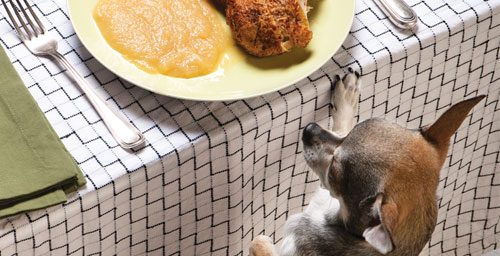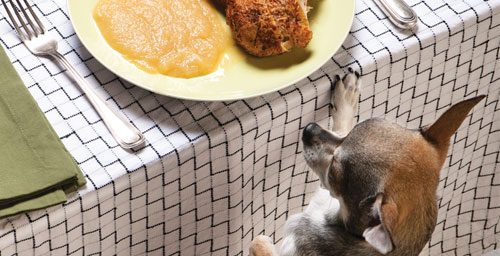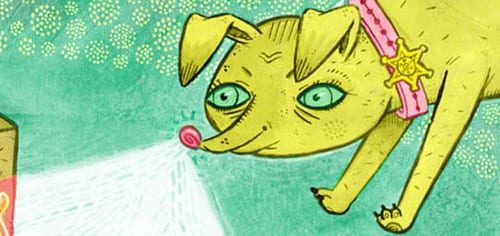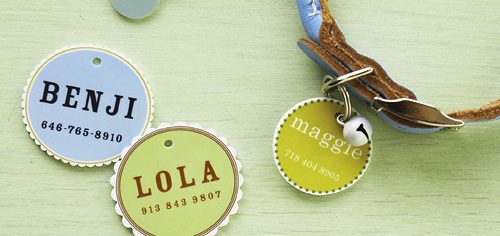

Food Rules
How dinnertime for your dog affects behaviour
Domino, Nancy’s five-year-old sweet-tempered spaniel mix, seemed elated by the arrival of Eddie, a new Boxer puppy, into the
home. But that evening, when the playful ten-week-old made the mistake of sticking his nose into Domino’s dinner bowl, the
easygoing spaniel turned into a snapping turtle. Poor little Eddie learned the hard way just how sacred a dog’s dinner bowl is,
even to the nicest of dogs.
Chow Power
Dogs revere food. They think about it, anticipate it, revel in it, search for it. Even their anatomy, designed for catching and killing prey,
cries out, “show me the food!” When they have those cute little running dreams, they are in truth chasing something they want to eat.
Unlike we humans, who usually reach a point of satiation, most dogs will eat until they reach the bursting point, and then eat a bit
more. It’s an instinct passed down from wolves, who, if lucky enough to kill a deer or moose, would gorge themselves, knowing that
the next meal might be days off. And so most dogs, if given the chance, will eat whenever food comes their way.
That’s mine!
The dog’s obsession with all things food can sometimes cause behavioural problems, even among the sweetest of pooches. For
instance, feeding an insatiable young dog beside an older, slower-eating pet can often provoke an aggressive altercation, when the
pushy youngster turns to the elder’s dish for “seconds.” Or, if the older dog doesn’t object, the youngster will scarf the senior’s food
down too, resulting in eventual obesity for one, and malnutrition and emotional strain for the other. As amazing as it may seem, many
owners with one chubby dog and one emaciated pooch never notice what’s really going on.
Some food-crazy dogs will become protective over their bowl to the point that they’ll literally bite the hand that feeds them, if it
comes too close during the meal. Many owners won’t even be aware of this until they are occasioned to reach into the dog’s bowl or
move it during the meal. When a snarl or nip ensues, the shocked guardian either does nothing or else overreacts physically or emotionally,
compounding the problem.
The Cost of Free-Feeding
Though most dogs will do anything for a meal, if food is made available to them all the time, their food drive will actually dwindle,
often to the point where it becomes difficult to use food as a motivator for training. Additionally, this practice of “free-feeding” often
results in a finicky eater, whose guardians, in an attempt to stimulate the dog’s appetite, will begin offering all manner of tidbits and human foods as incentives. This results in pushy, begging
behaviour, a placating relationship, and a spoiled dog. An ironic
side effect of free-feeding is that the dog, instead of enthusiastically
eating her meals at prescribed times, instead picks at
the food in her bowl all day, which the guardian keeps refilling
and refilling. The free-fed dog often ends up eating twice what
it needs to, resulting in obesity.
Timing and Frequency
When a dog eats can be as important
as what it eats. If you feed your dog
too late in the evening, you might
increase the odds of her having
a housetraining accident in
the middle of the night. Or, if
you feed your dog at random
times, you won’t be allowing
her digestive tract to
develop its own “rhythm,”
again resulting in an unpredictable
elimination schedule.
Feed your dog too early
in the morning, and you could
encourage her to become a foodcrazed
maniac later that evening.
How often you feed can affect
behaviour too. Take a dog with a high
food drive and feed her only once a day and
you could create a stressed-out pet that’s constantly
searching for handouts or one that tries to break into the
cupboards or garbage. Feed a picky eater two or three times
per day and you could lower her food drive even more, compounding
the dog’s culinary disinterest. Keep an adult dog on
a puppy’s feeding schedule (three times per day), and you’ll
most likely invite obesity and unpredictable elimination habits.
Where’s Dinner?
The location of your dog’s bowl can affect her day-to-day
behaviour, for the good or bad. For instance, feeding your
dog in the kitchen teaches her to consider that room as an
acceptable place to loiter. As it’s the place where you keep and
prepare your own meals, this often results in pesky begging
behaviour, garbage or cupboard raiding, or at the very least,
creates a floor licker.
As mentioned before, feeding two or more dogs in the same
room can result in aggression, obesity, malnutrition, and a
level of stress that has no place in such an important part of
a dog’s day. Instead of being a dog’s favourite event, it can
become a competitive, worrisome contest. The ensuing tension
will often be redirected into misbehaviours such as destruction,
barking, fighting, marking or even a breakdown
of housetraining.
The Joy of Food
Feeding time shouldn’t be troublesome,
tense, confrontational, or
cause for misbehaviour. Instead, it
should be a happy, exciting event
for the dog, and an affirmation
of your love and authority. Here
are some basic rules that, if
followed, should minimize foodrelated
behavioural issues, and
bring the joy back into
dinnertime.
1. Respect the sanctity of feeding
time. Feed your dog in low-traffic areas,
away from other pets, kids, or activity. Be
sure to separate multiple dogs to prevent theft and
fights. If need be, feed in crates or separate rooms. Keep
bowls out of the kitchen to prevent begging and confusion with
human food preparation.
2. Feed on a regular schedule. Doing so helps to stabilize
a dog’s housetraining habits and create a healthy food drive,
required for training, which initially relies on food rewards.
Though most adult dogs do fine on a once a day feeding schedule,
dogs with a high food drive may need to eat twice per day
to quell misbehaviours related to their unfulfilled, voracious
appetites. Though puppies do need to eat more often than
adults, be sure to cut back from three times a day to twice a
day by six months of age, or even sooner for giant breeds, who
need to avoid growing too fast. Feeding to much to a large breed puppy can cause debilitating joint problems that might
shorten a big dog’s life. Try not to feed your dog too early or too
late, as both can affect housetraining.
3. Don’t free-feed. It encourages finicky eating, lowers a dog’s
food drive (affecting training effectiveness), and can lead to
obesity. Like wolves, domestic dogs are designed to eat a full,
healthy meal, rather than to “graze” all day, like a ruminant.
4. Pay attention to your dog’s weight and appetite. Weight
gain can occur so slowly that an owner might not even notice,
so consider weighing your dog at least once each month. Steady
weight gain can be indicative of food theft from another pet,
the feeding of excessive amounts, or even too many treats in
between meals. Remember, keeping your dog’s appetite keen is
crucial to behaviour modification and to your ability to focus her
on you, the food provider.
5. Train your dog to welcome people touching her bowl.
Though dinnertime should be free of distraction for your pooch,
it’s vital that you or other persons be able to touch her bowl
whenever necessary without fear of aggression. To do so, get
into the habit of picking up your dog’s empty bowl, right in front
of her, and then dropping a delicious treat into it. Place it down,
wait for it to be eaten then repeat a few more times. Then do
the same during dinner time: walk over with a piece of turkey
meat, let her see it, then pick up the food-laden bowl and drop
the turkey in. Place the bowl down, let her eat, then repeat a few
times throughout the meal. Very quickly, your dog will learn to
welcome you touching her bowl!
Understanding the importance of food to a dog is crucial to
maintaining predictable behaviour, and a calm, relaxed demeanor.
By regulating and, if need be, adjusting how and when you
feed her, you’ll take a big step in minimizing bad behaviours and
making life for everyone happier and healthier.
Join the newsletter and never miss out on dog content again!
"*" indicates required fields
By clicking the arrow, you agree to our web Terms of Use and Privacy & Cookie Policy. Easy unsubscribe links are provided in every email.





